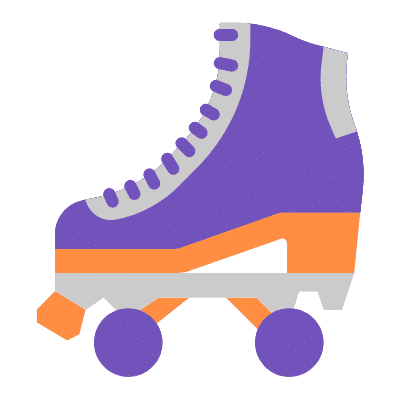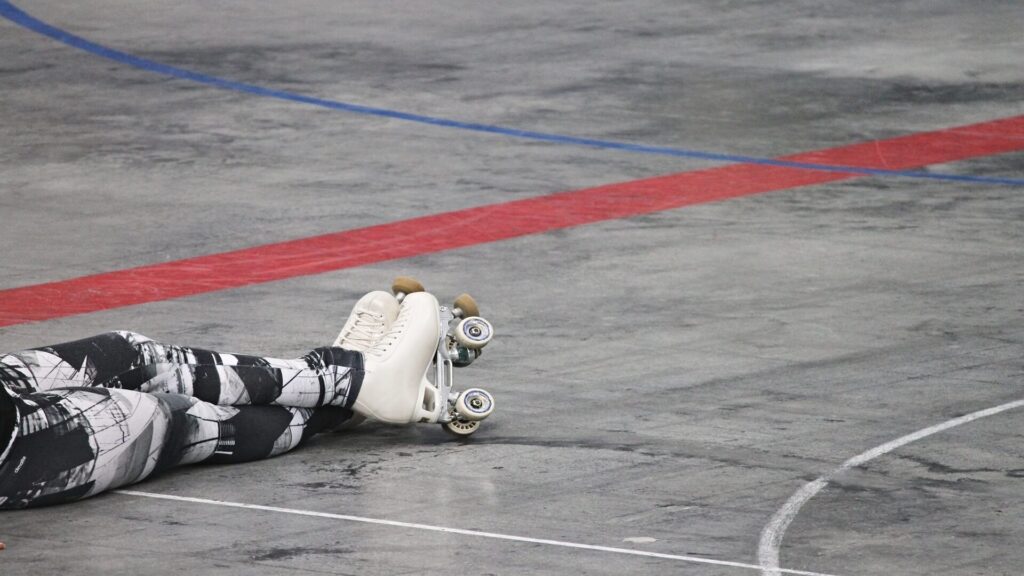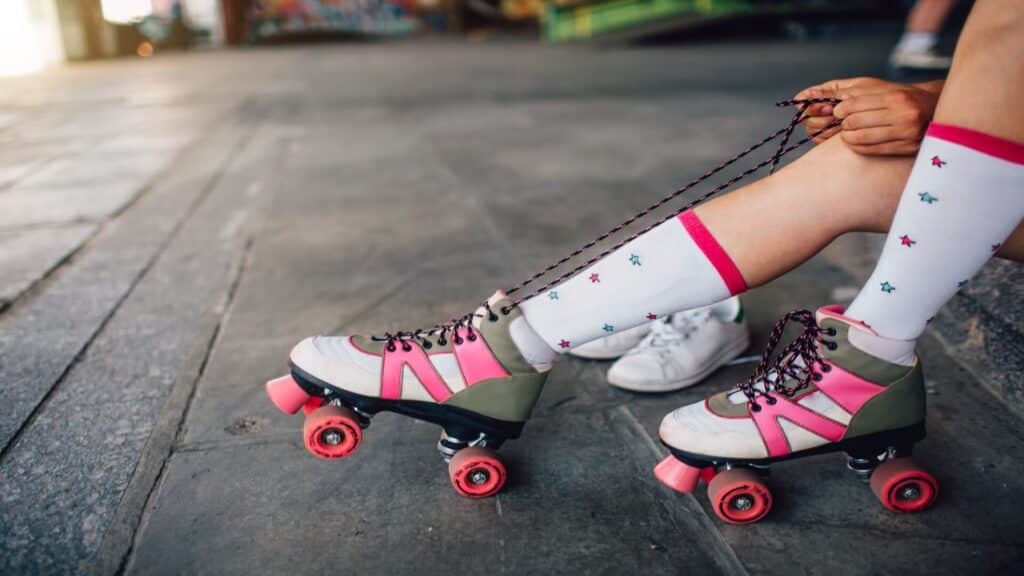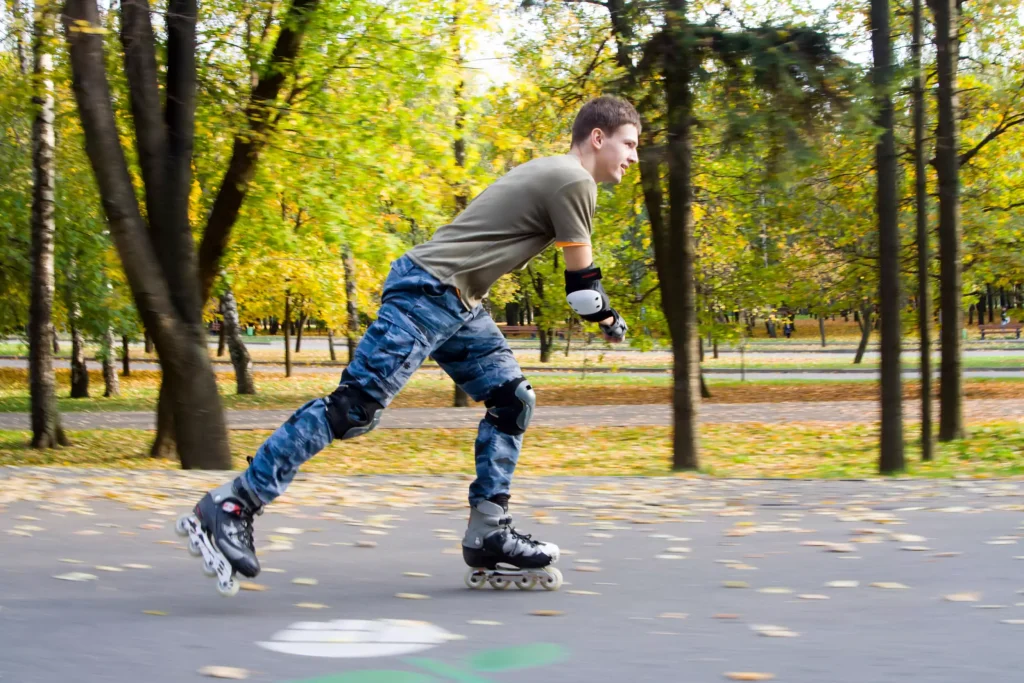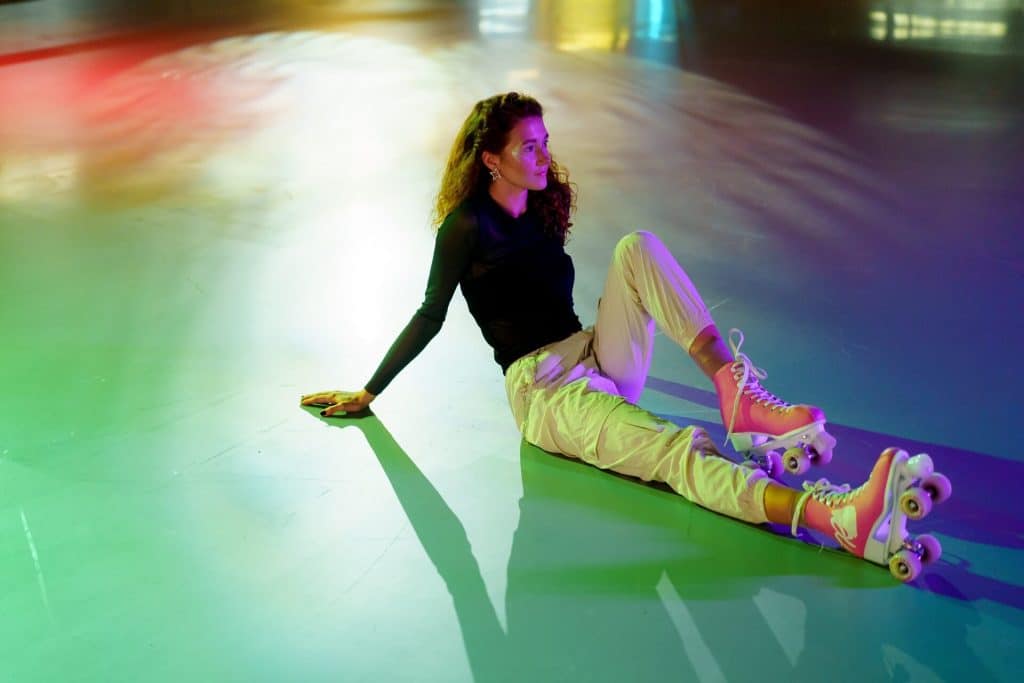Roller skating is a fun, enjoyable activity that provides an excellent workout for people of all ages. Gliding on wheels is a liberating feeling and a great form of exercise. However, like any sport requiring specialized equipment, getting the proper fit is crucial in roller skating. Knowing how to accurately size roller skates for your feet is the key to maximizing comfort, performance, and safety on the rink. Ill-fitting skates can quickly turn a joyful activity into a painful struggle.
In this comprehensive guide, we will delve deeper into the intricacies of how to size roller skates correctly. We’ll examine the different types of skates, key measurements to take, sizing charts to understand, and tips for getting the ideal width and length. You’ll learn how to assess skate fit, properly lace for adjustments, break skates in, and care for them. With the foundation provided here, you can feel confident you’ll choose well-fitted skates for smooth, enjoyable, and injury-free skating. The freedom and exercise skating provides is invaluable at any age. Let’s get started on getting you the perfect pair!
Table of Contents
Understanding Roller Skate Sizing
Comprehending roller skate sizing systems is the first key step in learning how to size skates properly. There are two main sizing charts to understand – adult and children’s.
Adult skate sizes are primarily based on foot length. Length is measured in centimeters from the heel to the tip of the longest toe. Adult sizes also correspond to standard shoe sizes. So an adult with a shoe size of 9 in the US system would start with a size 9 roller skate.
However, skate sizes can vary slightly from shoe sizes due to the tighter, performance-oriented fit required. It’s crucial to refer to each manufacturer’s unique adult sizing chart for precise length-to-size conversion.
For children’s sizing, age is used as a very rough guide. But foot size can fluctuate substantially among kids of the same age. So while a general age range is a starting point, carefully measuring the child’s actual foot dimensions takes priority.
Allow substantial room for growth when selecting children’s skate sizes. Choose a current size that fits properly but also accommodates the rapid growth of children’s feet over months. For example, purchase a size 5 skate for a 4-year-old with a size 4 foot. Re-size as needed every 1-2 months initially.
Children’s vs Adult Skate Sizing
Several key differences exist between children’s and adult roller skate sizing:
- Children’s feet are constantly growing, sometimes very rapidly over short periods. Allow 1-2 sizes of room for growth when sizing kids’ skates.
- Width merits special attention for children. Many kids have feet wider relative to their length. Ensure adequate width to prevent discomfort on the sides of the feet.
- Children may need more flexibility in sizing as their feet change. Consider adjustable skates that can expand as feet grow.
- Adult skate sizing is more static and based on current foot dimensions. Still, re-measure every 6-12 months to account for any changes.
- For adults, precise measurement of both foot length and width is key. Accurately determine your needs for both standard/wide widths and sizes.
- Adult skates prioritize performance elements like snugness and support. Children’s skates emphasize comfort, room for growth, and ease of wear.
Getting the Width Right
Beyond foot length, paying attention to width sizing is critical for a proper roller skate fit. Ill-fitting skates that are too narrow can cause major issues:
- Discomfort on the sides of the feet – This can range from moderate to extreme pain on the lateral and medial sides depending on how narrow the skates are. Discomfort can be felt in the pinky toe, ball of the foot, and heel areas in particular.
- Balance problems – Narrow skates constrict the foot, reducing stability. This makes it harder to balance on the skates, especially for beginners. Poor balance leads to wobbling and falling more frequently.
- Difficulty controlling movements – With feet restricted, it’s harder to execute skating maneuvers like crossovers, turns, and stops. Lack of control affects performance.
- Inability to generate power – Narrow skates reduce force transfer and power generation when striding. This decreases speed and hinders acceleration.
- Decreased agility – Constraint on the feet’s range of motion prevents quick edge changes and agile movements. This significantly limits agility and responsiveness.
- Blisters/calluses – Excess pressure on the sides of the feet in narrow skates causes blisters or calluses to develop as problem areas rub constantly.
Before we continue, here is a tutorial video on how to size roller skates (both quad and inline) by the YouTube channel: Ricardo Lino
Tools Needed for Measuring Foot Size
Before diving into how to size roller skates, gathering the necessary tools is essential. You’ll need a blank piece of paper, a pencil or pen, a ruler or measuring tape, and a pair of socks akin to the ones you intend to wear while skating. These tools will aid in acquiring precise foot measurements.
How to Measure Your Feet
To find the perfect fit, you need to measure your feet accurately. Here’s a detailed guide:
- Position the paper on a flat surface. With your skating socks on, step onto it with one foot.
- Use a pencil to trace the outline of your foot. Try to keep the pencil upright and close to your foot for a precise outline.
- Use the ruler or measuring tape to measure the length of your foot (from the heel to the tip of your longest toe) and the width (at the widest part across your foot, which is usually across the ball of the foot). Make sure to measure in centimeters or inches, depending on the standard used in the skate size chart you’ll refer to later.
- Repeat the same process for your other foot.
It’s worth noting that most people have one foot slightly larger than the other, so it’s best to select your skate size based on the larger foot’s measurements.
Interpreting Your Measurements and Checking Size Charts
After taking measurements, you can compare them with roller skate size charts. Each skate manufacturer will have its unique size chart, so it’s crucial to check the one corresponding to the brand you’re interested in.
Compare your foot’s length and width with the measurements in the size chart. If you’re in between two sizes, go for the larger size. Keep in mind that foot width also plays a part; individuals with wider or narrower feet may need special sizing.
Also, don’t forget to consider additional factors such as foot growth (particularly important for children) and the inner padding of the skate, which can affect the size choice.
Using Lacing Techniques for a Proper Fit
Beyond selecting the right width and size, lacing techniques can help fine-tune the fit of your roller skates:
- Try loosening the laces over any pressure points where the skates feel too tight. This relieves discomfort in isolated areas.
- Tighten laces in places where your foot feels loose inside the boot to take up volume. This prevents sliding around.
- Adjusting laces in specific areas creates even pressure distribution for comfort.
- Leave laces looser around the toe box for wiggle room and tighter at the ankles for support.
- Use the ladder lacing method to customize fit – run the laces straight across loose areas but crisscross over tight spots.
- For narrow feet in a standard-width skate, lace tightly from midfoot to heel for a snugger fit.
- Wider feet can benefit from heel locks to prevent lift. Loop laces around the ankle bones before tying.
Experiment with lacing tightness, patterns, and techniques across the upper to dial in your perfect fit. Having skates properly broken in also helps mold the boot to your foot.
How to Check the Fit of Roller Skates
After making an educated guess on your size based on measurements and size charts, the final step in how to size roller skates is trying them on.
Put on your skating socks and slide your foot into the skate. When standing up, your toes should just touch the front of the boot, and your heel should sit firmly against the back. The skate should feel snug but not tight. You should be able to wiggle your toes, but your foot shouldn’t slide around inside the boot.
Considerations for Different Types of Roller Skates
Depending on the type of roller skate you’re interested in, sizing can differ slightly. For example, inline skates (rollerblades) often require a tighter fit than quad skates due to their different structure and the different techniques used when skating.
Skaters should also consider the specific demands of speed skates, derby skates, and recreational skates. Each of these types comes with unique design features and thus can influence the size selection.
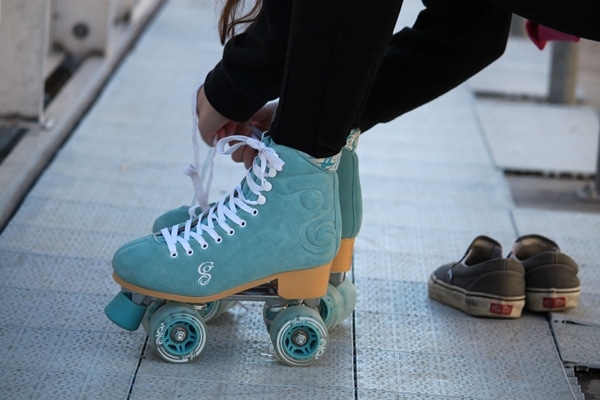
Importance of Trying Before Buying
A key aspect of knowing how to size roller skates is the emphasis on trying them on before making a purchase. While online shopping offers the convenience of home delivery, it doesn’t provide the opportunity to physically try on the skates.
Each shopping method has its pros and cons, so consider them carefully. If you’re shopping online, look for retailers with comprehensive size guides and good return/exchange policies to help you find the perfect fit.
Maintenance Tips to Keep the Skates Fitting Properly
Proper maintenance of roller skates can ensure they continue to fit well and last longer. Cleaning and airing out your skates can prevent them from losing shape due to accumulated moisture and odor.
Monitor the condition of your skates, and don’t hesitate to replace parts such as wheels and bearings when they wear out. These components play a significant role in the fit and comfort of your skates, and timely replacements can help maintain optimal performance.
Understanding the Break-In Period for New Roller Skates
Once you’ve found your perfect pair of roller skates, it’s important to remember that, like many other types of footwear, they may require a break-in period. This means that the skates might feel a bit stiff or even somewhat uncomfortable at first. This is perfectly normal and nothing to worry about.
The break-in period is the time it takes for the materials of your new skates to adapt to the shape of your feet and your skating style. During this period, the skates’ inner padding and upper materials will gradually mold around your feet, providing a custom fit.
To speed up this process, you can start with shorter, easier skate sessions and gradually increase the duration and intensity as your skates become more comfortable. If you feel discomfort in specific areas, you can use heat molding techniques or add some padding to alleviate the pressure.
Remember, every skater’s break-in experience is unique and can range from a few hours to a few weeks of skating. Patience is key here. Once your skates are fully broken in, they’ll feel like a natural extension of your feet, offering maximum comfort and performance while you roll around. So, understanding and respecting the break-in period is a valuable addition to knowing how to size roller skates.
For more information, you can read our guide about how to break in new roller skates.
Tips for Making Roller Skates Fit Better
There are things you can try if your new roller skates feel too tight in certain areas:
- Wear thin cotton socks or sock liners to take up less volume in the boots. Thick socks can make properly fitted skates feel too snug.
- Use a hair dryer on a low heat setting to gently heat problem areas and mold the rigid outer boot material to expand it slightly. Let cool down before skating.
- Spraying a small amount of rubbing alcohol on tight spots can also help dampen and expand synthetic materials. This method softens the boot.
- Use mole foam, gel pads, or padded tape on areas prone to blisters or pressure points. This creates a buffer zone to relieve friction.
- Have the skates professionally heat molded at a skate shop. This uses specialized ovens and molds to custom contour the boots around your feet.
- Get professionally fitted inline skates with customizable liners that mold as they are heat-treated. These are thermoformable for a custom fit.
- For leather or suede skates, a leather conditioner can soften and expand the material slightly if too stiff initially.
- Replace the original insole with an aftermarket insole for more cushioning or support.
With some patience and targeted tweaks, you can improve the fit and comfort of stiff, tight skates substantially. Don’t give up too quickly during the break-in period.
Conclusion
Learning how to properly size roller skates is essential for comfort, performance, and safety. With the right length, width, and fit, skates become an extension of your feet rather than a hindrance.
Carefully measure both feet and consult accurate sizing charts to determine your needs. Be sure to account for the type of skating, foot dimensions, growth, and width. Take the time to try on skates and lace them optimally. Consider custom heat molding for problem feet.
Break skates in gradually to allow materials to mold to your feet. Proper maintenance will prolong their lifespan. Re-size as needed over time. Finding the perfect pair of skates takes effort but enables you to skate with ease.
We hope this guide has helped you learn the ins and outs of sizing roller skates correctly. Please don’t hesitate to contact us if you need any additional sizing help or have questions. Our trained staff is happy to provide free consultations to get you rolling in comfortable, well-fitted skates.


